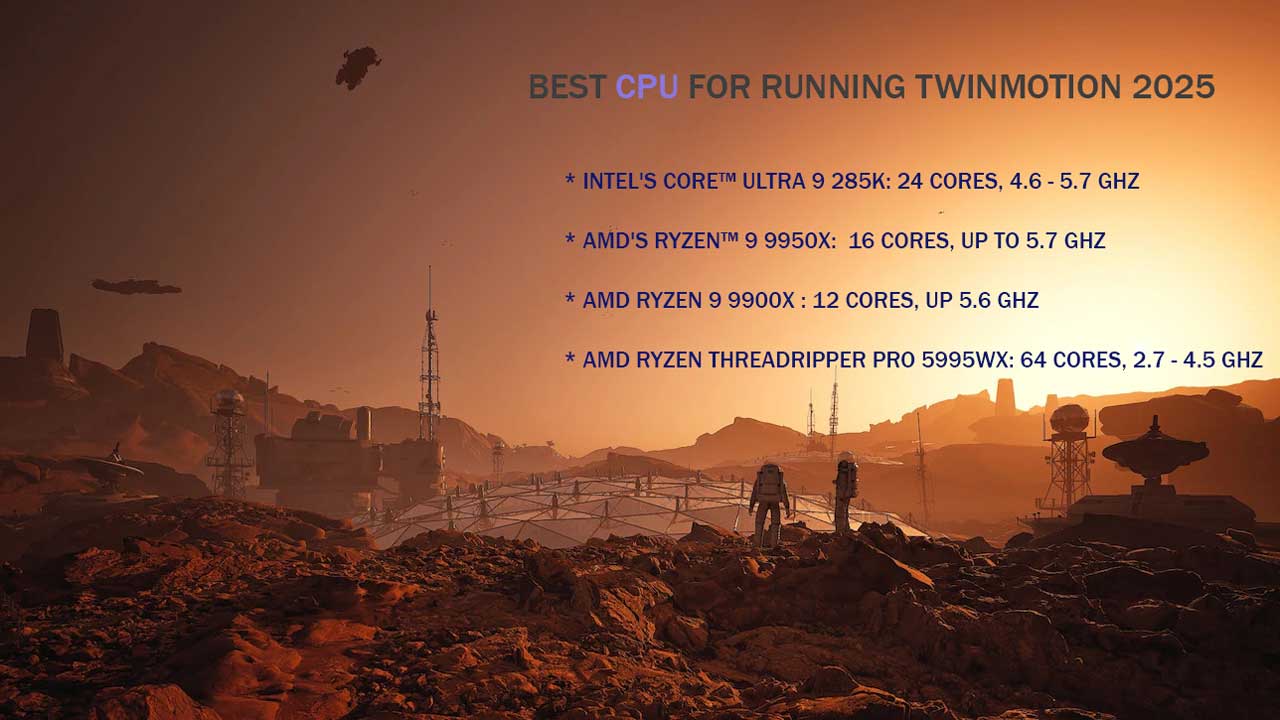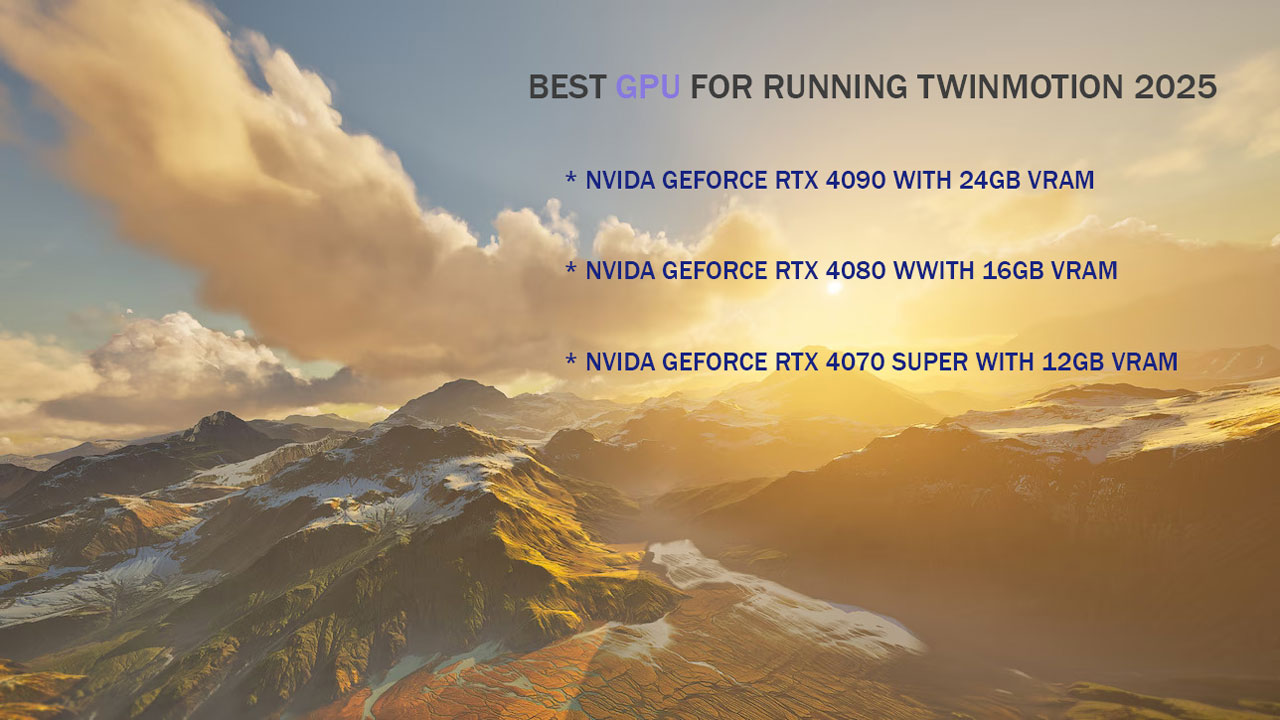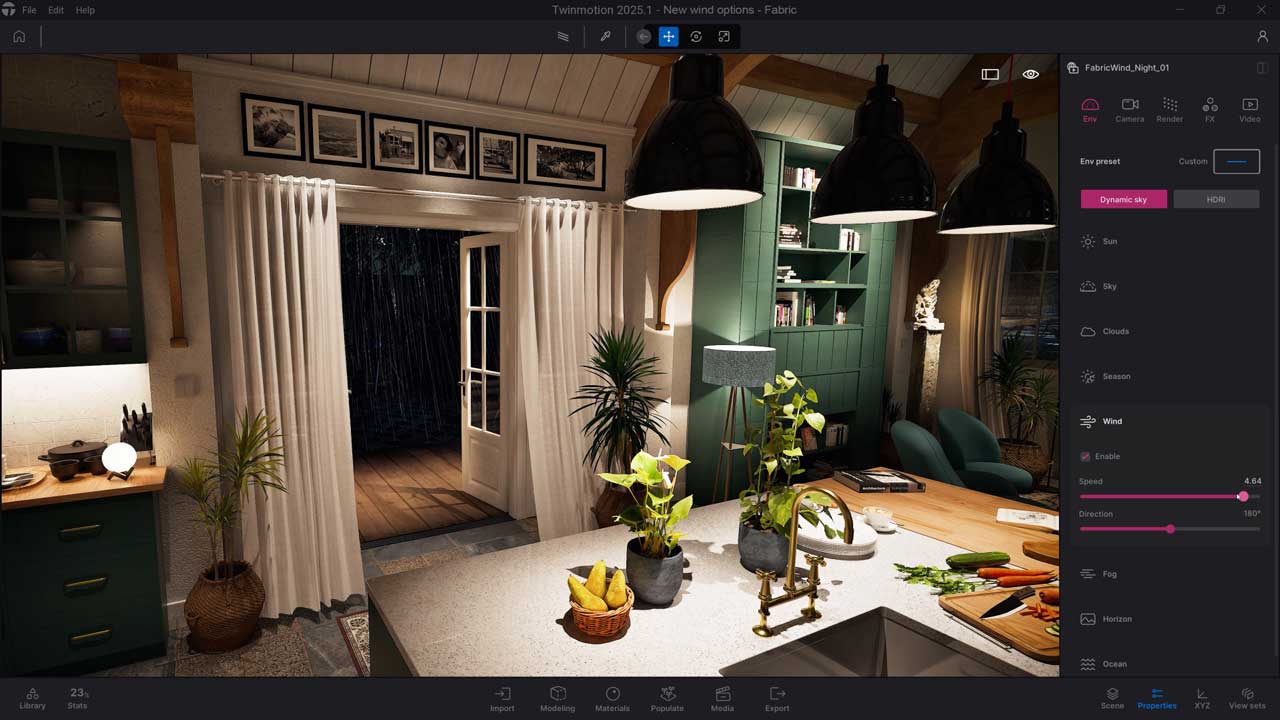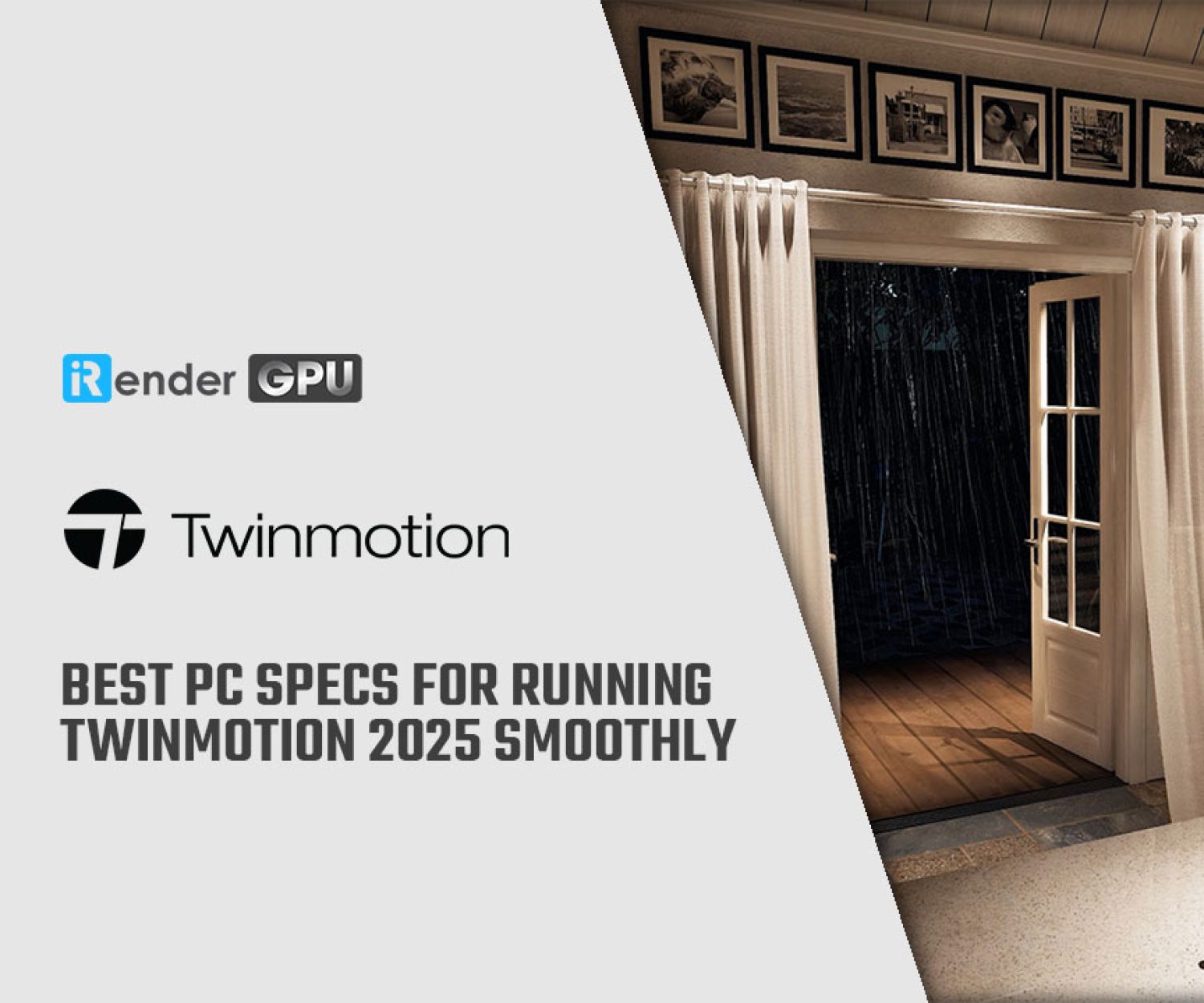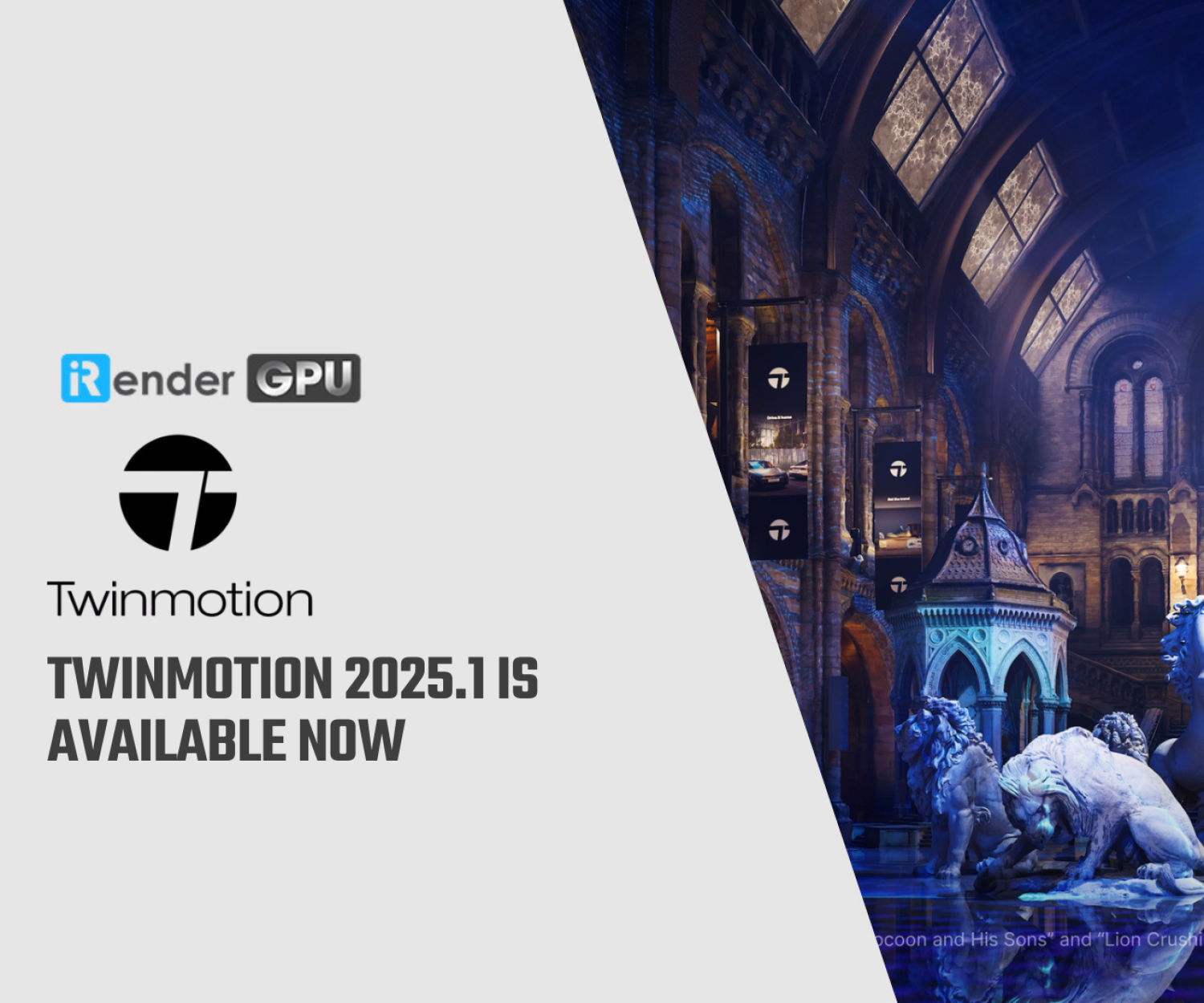Best PC Specs for Running Twinmotion 2025 Smoothly
Twinmotion is a real-time 3D architectural visualization software that easily creates standard or high-quality 360° virtual reality images, panoramas, and videos in only seconds. Twinmotion 2025 pushes the boundaries of real-time architectural visualization, offering more realistic rendering, smoother performance, and enhanced productivity tools. Whether you’re an architect, designer, or 3D artist, having the right hardware setup is crucial to fully experience everything Twinmotion 2025 has to offer. A well-optimized PC not only ensures smoother workflows but also allows you to take full advantage of advanced features like high-resolution rendering, dynamic lighting, and immersive VR integration.
In this article, iRender will explore the best PC Specs for Running Twinmotion 2025 Smoothly!
Overview of Twinmotion 2025
Twinmotion 2025 marks another significant leap forward in real-time visualization technology. Twinmotion was built on the powerful Unreal Engine backbone, this version brings enhanced realism, better performance, and an even more intuitive user experience. It’s designed to help architects, designers, and urban planners visualize their ideas with stunning clarity.
One of the standout features of Twinmotion 2025 is its improved rendering engine. Users can now achieve even more photorealistic results, thanks to enhanced global illumination, more accurate material reflections, and better support for physically based materials. The software also introduces refined lighting systems, improved weather simulation, and expanded vegetation and asset libraries, giving users more creative flexibility when building their scenes. Moreover, Twinmotion 2025 delivers smoother scene handling, faster render times, and better compatibility with BIM and CAD software like Archicad, Revit, SketchUp, and Rhino.
Additionally, Twinmotion 2025 continues to support immersive experiences with VR capabilities and enhanced animation tools.
System Requirements for Twinmotion 2025
Minimum Requirements
- Central Processing Unit (CPU): A processor with a benchmark score of 2,000 or higher.
- System Memory (RAM): 16 GB or more
- Hard Drive: 30 GB of free disk space
High-end Requirements
- Central Processing Unit (CPU): A processor with a benchmark score of 2,500 or higher.
- System Memory (RAM): 64 GB or more
- Hard Drive: 30 GB of free disk space
To ensure optimal performance when operating Twinmotion on Windows, specific hardware and software requirements must be met. Although the application is capable of running on Windows 7 and Windows 8.1 (64-bit versions), these operating systems are no longer officially supported, as Microsoft has ceased providing updates and support for them. For a stable and efficient experience, Twinmotion is fully compatible with Windows 10 (64-bit), beginning with version 1909 revision .1350 or later, as well as versions 2004 and 20H2 revision .789 or higher. Compatibility is also extended to Windows 11 (64-bit), which is recommended for contemporary use.
Similarly, on macOS, certain system requirements are necessary to ensure the smooth operation of Twinmotion. The minimum supported version of the operating system is macOS Monterey 12.5. However, for users engaging in more advanced or resource-intensive workflows, macOS Sonoma 14.6.1 is recommended to achieve optimal performance and stability.
Best PC Specs for Running Twinmotion 2025 Smoothly
Processor (CPU)
When choosing CPUs, two primary specifications determine their overall performance capabilities. The first is clock frequency, which influences the number of operations a single CPU core can execute per second—essentially reflecting the processing speed of each core. The second is the core count, which refers to the total number of physical cores within the processor, indicating how many tasks can be handled concurrently. The relative importance of clock speed versus core count depends on how efficiently a given software application is optimized to utilize multiple cores simultaneously. For optimal utilization of Twinmotion, it is advisable to select a processor that offers a high clock frequency complemented by a moderate number of cores. This requirement closely parallels that of Unreal Engine, which is unsurprising given that both platforms are developed by Epic Games and exhibit similar performance characteristics. Processors from AMD’s Ryzen series and Intel’s Core series are well-suited to meet these specifications. In particular, the Intel Core i9-13900K and AMD Ryzen 9 7950X are regarded as among the most effective options available, delivering the processing power necessary to ensure smooth and efficient operation of Twinmotion.
Graphics Card (GPU)
In Twinmotion, the graphics card is responsible for rendering and displaying 3D models in real-time. As project complexity increases, so too does the demand for a more powerful GPU. In general, higher-performance graphics cards contribute significantly to improved responsiveness and visual quality within the software. Additionally, the amount of dedicated graphics memory (VRAM) plays a critical role, particularly when working with intricate or large-scale models. At present, the NVIDIA GeForce RTX 4090 with 24GB of VRAM represents the highest-performing GPU for use with Twinmotion. However, the RTX 4080 (16GB) and RTX 4070 SUPER (12GB) also provide strong performance and are suitable for beginners.
Memory (RAM)
To ensure smooth performance while using Twinmotion 2025, having sufficient system memory (RAM) is essential. Adequate RAM allows the software to operate efficiently, especially when working on complex scenes or large projects. It helps the system manage multiple tasks and data processes simultaneously, reducing lag and improving overall responsiveness during design and rendering tasks. When running Twinmotion, Epic lists a minimum of 16GB for Twinmotion for optimal performance. For more demanding projects involving high-resolution textures, complex models, or large-scale environments, 32 GB or more of VRAM is ideal. A higher VRAM capacity ensures smoother real-time rendering, better visual quality, and faster performance, especially when working with photorealistic assets or exporting high-quality visuals and animations.
Storage (Drives)
For running Twinmotion 2025 efficiently, having the right storage drive is important. We strongly recommend a Solid-State Drive (SSD), as it offers significantly faster data access and loading times compared to traditional hard drives. Using an SSD helps speed up software startup, project loading, and the overall workflow, especially when dealing with large files and high-resolution assets. Ensuring sufficient free storage space also allows Twinmotion to perform smoothly and reduces delays during rendering or saving projects.
At iRender, all our servers are equipped with 2TB of NVMe storage, which offers a significant benefit for Twinmotion users. This high-speed storage allows users to run Twinmotion alongside other applications simultaneously, making it easier to multitask and handle various important tasks efficiently.
Overall
Choosing the ideal PC for Twinmotion largely depends on your budget, the software’s requirements, and how important portability is to you. Whether you need maximum rendering performance, a lightweight setup, or a combination of both, there’s a suitable option to enhance your creative work. Taking the time to research and understand your specific workflow is crucial in choosing a system that can run Twinmotion efficiently and take your architectural visualizations to the next level. Wishing you great success in your rendering journey!
As almost all users know, virtual machines do not support Twinmotion.
iRender is proud to be one of the best GPU service providers on the market supporting Twinmotion. All servers at iRender are physical machines, so users will use 100% hardware usage, no sharing with anyone else. iRender offers from 1/2/4/6/8 RTX 4090s and 3090s. In addition to offering powerful configurations, all servers at iRender are also equipped with AMD Ryzen™ Threadripper™ PRO 3955WX @ 3.9 – 4.2GHz or AMD Ryzen™ Threadripper™ PRO 5975WX @ 3.6 – 4.5GHz, 256GB RAM, 2TB Storage NVMe SSD. The high-end configuration is extremely suitable for complex Twinmotion projects.
Let’s see how Twinmotion rendering speed test on iRender’s RTX 4090 and RTX 3090:
The price is very flexible and suitable for Twinmotion projects from small to large. Moreover, iRender always has a 24/7 online Support Team to help you handle problems immediately. This month we have a hot BONUS:
Let’s create an ACCOUNT and try our render beast for your Twinmotion projects. For further information, please do not hesitate to reach us at [email protected] or mobile/ WhatsApp: +(84) 916017116, Skype: Lina iRender.
iRender – Happy Rendering!
Reference source: Twinmotion, ProxPC
Related Posts
The latest creative news from V-Ray Cloud Rendering , Twinmotion Cloud Rendering , 3D VFX Plugins & Cloud Rendering.


